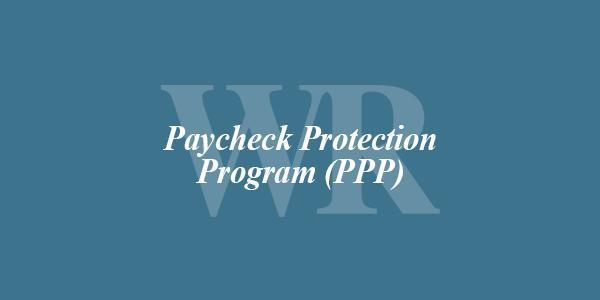
SC Business Personal Property tax filing dates
April 23, 2020
More funds available from HHS general funds to Healthcare providers
April 27, 2020Paycheck Protection Program Update – 4/26/20

As the SBA opens its online portal and is processing loans to allocate the new $310 billion of Paycheck Protection Program (PPP) funds, we continue to look for new guidance on the program. Late last week and over the weekend, the SBA and US Department of the Treasury posted new guidance regarding the PPP through their FAQs. Of note, there was guidance on large businesses with adequate sources of liquidity qualifying for loans, determining an individual employee’s principle place of residence, and how part-time employees are considered in the under 500-employee requirement for eligibility and how they are considered when determining forgiveness. Below are the specific questions and answers directly from the FAQs along with our comments on each. You can view the full FAQs document here.
Question: Do businesses owned by large companies with adequate sources of liquidity to support the business’s ongoing operations qualify for a PPP loan?
Answer: In addition to reviewing applicable affiliation rules to determine eligibility, all borrowers must assess their economic need for a PPP loan under the standard established by the CARES Act and the PPP regulations at the time of the loan application. Although the CARES Act suspends the ordinary requirement that borrowers must be unable to obtain credit elsewhere (as defined in section 3(h) of the Small Business Act), borrowers still must certify in good faith that their PPP loan request is necessary. Specifically, before submitting a PPP application, all borrowers should review carefully the required certification that “[c]urrent economic uncertainty makes this loan request necessary to support the ongoing operations of the Applicant.” Borrowers must make this certification in good faith, taking into account their current business activity and their ability to access other sources of liquidity sufficient to support their ongoing operations in a manner that is not significantly detrimental to the business. For example, it is unlikely that a public company with substantial market value and access to capital markets will be able to make the required certification in good faith, and such a company should be prepared to demonstrate to SBA, upon request, the basis for its certification.
Lenders may rely on a borrower’s certification regarding the necessity of the loan request. Any borrower that applied for a PPP loan prior to the issuance of this guidance and repays the loan in full by May 7, 2020 will be deemed by SBA to have made the required certification in good faith.
Comments: This guidance came out seemingly in response to the “Shake Shack issue” making headlines last week. There were over 200 publicly traded companies that applied for and received PPP loans. While certainly we heard several elected officials comment that this money was not intended for publicly traded or cash rich PE backed companies, it is important that all business owners applying for PPP loans carefully review the required certification and feel comfortable making the certification of need. If you have applied and received a PPP loan, it would be good to document your reasoning and/or any data or analysis performed to determine your need for the loan. There may come a time when this information is requested.
If you received a loan and now believe your company is not in a position that it should have applied, you have until May 7th to repay the full loan.
We are unable to advise individual clients on their eligibility relative to the certification of need. If you have questions concerning your business’s eligibility, we suggest that you consult with your legal counsel.
Question: Is there existing guidance to help PPP applicants and lenders determine whether an individual employee’s principal place of residence is in the United States?
Answer: PPP applicants and lenders may consider IRS regulations (26 CFR § 1.121- 1(b)(2)) when determining whether an individual employee’s principal place of residence is in the United States.
Comments: In order to determine if an employee’s principle place of residence is in the US, the SBA is going to use the IRS standard set for determining principle residency for the purpose of excluding gain from the sale or exchange of a principle residence (found here). While this may seem like an unusual choice for determination, at least we now have clear guidance. Companies that traditionally use workers from overseas may need to reconsider what they thought of as employee’s with principle residence here in the US when they originally applied for the loan.
Question: To determine borrower eligibility under the 500-employee or other applicable threshold established by the CARES Act, must a borrower count all employees or only full-time equivalent employees?
Answer: For purposes of loan eligibility, the CARES Act defines the term employee to include “individuals employed on a full-time, part-time, or other basis.” A borrower must therefore calculate the total number of employees, including part-time employees, when determining their employee headcount for purposes of the eligibility threshold. For example, if a borrower has 200 full-time employees and 50 part-time employees each working 10 hours per week, the borrower has a total of 250 employees.
By contrast, for purposes of loan forgiveness, the CARES Act uses the standard of “fulltime equivalent employees” to determine the extent to which the loan forgiveness amount will be reduced in the event of workforce reductions.
Comments: This is another example of the loan application process using a different set of measures than the loan forgiveness. The CARES Act laid out using fulltime equivalent employees (FTEs) for the forgiveness calculation but we fielded many client questions around the number of employees to include on the PPP application. Now we know for sure. The “number of employees” box on the SBA application form is meant for total employees with principle residence in the US, not FTEs. If you were at or near the 500 employee mark and are not included in the excluded group of companies with NAICS code beginning with 72, you may need to revisit this calculation.
We continue to closely monitor new guidance being released and will continue to update you on new developments. If you have questions or need assistance, we are here to help. Reach out to your WR Partner or your relationship manager.
Sincerely,
WR COVID-19 Task Force


